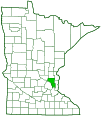variable eastern taedia mirid
(Taedia scrupea)
Conservation • Description • Habitat • Ecology • Distribution • Taxonomy
|
|
||||||||||||||
Description |
Variable eastern taedia mirid is a small, native, early season, plant bug. It occurs in the United States and southern Canada east of the Great Plains. Adults are active from early May to late June. The larvae feed on mostly on wild grape, but also on cultivated grape, and occasionally on other plant species. Adults are ¼″ to 5⁄16″ (6.0 to 7.5 mm) long and about ⅛″ (2.6 mm) wide. The body is elongated oval and soft. The compound eyes are large and bulging. There are no simple eyes (ocelli). The mouth parts are optimized for piercing and sucking. They take the form of a long, 4-segmented beak. When not used, the beak extends from the front of the head, along the underside of the body between the legs, to the middle of the first segment (coxa) of the hind legs. The antennae are slender and thread-like. They have 4 segments. The first segment is thickly covered with long black hairs. The hairs are not flattened. The exoskeletal plate covering the first segment of the thorax (pronotum) is widest at the base and much narrower behind the head. The sides are straight and the rear is broadly rounded. There is a short but distinct, exposed collar in front. There is a small, oval tubercle (callus) at the front outer angle on each side of the pronotum behind the collar. There is a small but distinct rounded, black spot behind each callus. These spots sometimes merge with larger spots on the rear half of the pronotum. The surface of the pronotum is not pitted (punctate). There are two pairs of wings, and they are held flat over the body when at rest. The exoskeletal plate between the wing bases (scutellum) is large and triangular. The front wings (hemelytra) are longer than the hind wings and slightly longer than the body. The hemelytra have a thickened, leathery part at the base and a thin membranous part at the tip with a clear dividing line between the two. The thickened part is comprised of the narrow area (clavus) behind the scutellum when the wings are closed, and the broad marginal area (corium). At the end of the corium there is a small but distinct triangular area (cuneus). The hind wings are thin and membranous. The legs are moderately long. The third segment (femur) of the hind legs is swollen. The body structure of variable eastern taedia mirid is consistent across populations, but the coloration is unusually variable. Eighteen forms have been described based on differences in coloration. All forms are black, brownish black, or brownish gray (dark) with at least some areas of orange, yellow, pale red, or dark red (pale). They have two black spots (discal spots) on the pronotum near the front margin. On the hind legs, the fourth segment (tibia) is thickly covered with long hairs that obscure or become confused with the spines on that segment. The forms are named as subspecies or varieties in historic literature. They are now treated as color variations which are not given distinct taxonomic names. On the typical form, formerly var. scrupeus, the pronotum and the scutellum are orange or pale red. The area behind the discal spots is dusky to brownish black. On the hemelytra, the corium is grayish brown to brownish black. The leading edge (costal margin) is colored like the corium. |
Size |
Total length: ¼″ to X¾″ (6.0 to 7.5 mm) |
Similar Species |
Habitat |
|
Ecology |
Season |
Early May to late June |
Behavior |
|
Life Cycle |
|
Nymph Hosts |
Mostly wild grape |
Adult Food |
|
Distribution |
||
|
Sources |
|
| 2/7/2025 | ||
Occurrence |
||
|
||
Taxonomy |
|
Order |
Hemiptera (True bugs, Hoppers, Aphids, and Allies) |
Suborder |
Heteroptera (True Bugs) |
Infraorder |
Cimicomorpha |
Superfamily |
Miroidea |
Family |
|
Subfamily |
Mirinae |
Tribe |
Mirini |
Genus |
Taedia |
Subordinate Taxa |
|
|
|
Synonyms |
|
Capsus scrupeus Capsus tetrastigma Paracalocoris scrupeus ssp. ardens Paracalocoris scrupeus ssp. bicolor Paracalocoris scrupeus ssp. bidens Paracalocoris scrupeus ssp. compar Paracalocoris scrupeus ssp. cunealis Paracalocoris scrupeus ssp. delta Paracalocoris scrupeus ssp. diops Paracalocoris scrupeus ssp. lucidus Paracalocoris scrupeus ssp. nubilis Paracalocoris scrupeus ssp. par Paracalocoris scrupeus ssp. percursus Paracalocoris scrupeus ssp. rubidus Paracalocoris scrupeus ssp. sordidus Paracalocoris scrupeus ssp. triops Paracalocoris scrupeus ssp. varius Taedia ardens Taedia bicolor Taedia bidens Taedia compar Taedia cunealis Taedia delta Taedia diops Taedia lucidus Taedia nubilis Taedia par Taedia percursus Taedia rubidus Taedia sordidus Taedia tetrastigma Taedia triops Taedia varius |
|
Common Names |
|
variable eastern taedia mirid |
|
Glossary
Clavus
On Hemiptera: The hard part of the forewing that is adjacent to the scutellum when the wings are closed. Plural: clavi.
Corium
The thickened basal portion of the front wing that lies between the clavus and the membrane of insects in the family Hemiptera. Plural: coria.
Costal margin
The leading edge of the forewing of insects.
Cuneus
The triangular, hardened, horn-like tip of the forewing of a plant bug (family Miridae).
Femur
On insects and arachnids, the third, largest, most robust segment of the leg, coming immediately before the tibia. On humans, the thigh bone.
Hemelytron
The forewing of true bugs (order Hemiptera), thickened at the base and membranous at the tip. Plural: hemelytra.
Ocellus
Simple eye; an eye with a single lens. Plural: ocelli.
Pronotum
The exoskeletal plate on the upper side of the first segment of the thorax of an insect.
Punctate
Dotted with pits (punctures), translucent sunken glands, or colored spots of pigment.
Scutellum
The exoskeletal plate covering the rearward (posterior) part of the middle segment of the thorax in some insects. In Coleoptera, Hemiptera, and Homoptera, the dorsal, often triangular plate behind the pronotum and between the bases of the front wings. In Diptera, the exoskeletal plate between the abdomen and the thorax.
Visitor Photos |
||
Share your photo of this insect. |
||
This button not working for you? |
||
Alfredo Colon |
||
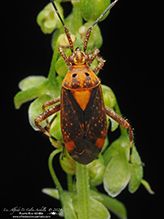 |
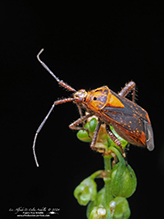 |
|
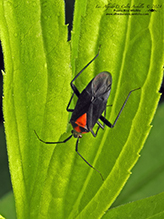 |
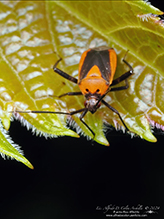 |
|
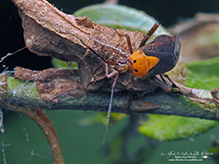 |
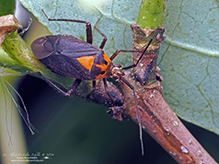 |
|
MinnesotaSeasons.com Photos |
||
|
||
|
||

Slideshows |
|

Visitor Videos |
||
Share your video of this insect. |
||
This button not working for you? |
||
|
Other Videos |
||
|

Visitor Sightings |
||
Report a sighting of this insect. |
||
This button not working for you? |
||
Alfredo Colon |
Location: Albany, NY |
 |
Alfredo Colon |
Location: Albany, NY |
 |
Alfredo Colon |
Location: Albany, NY |
 |
Alfredo Colon |
Location: Albany, NY |
 |
MinnesotaSeasons.com Sightings |
||
|

|
Created: 2/7/2025 Last Updated: © MinnesotaSeasons.com. All rights reserved. |
